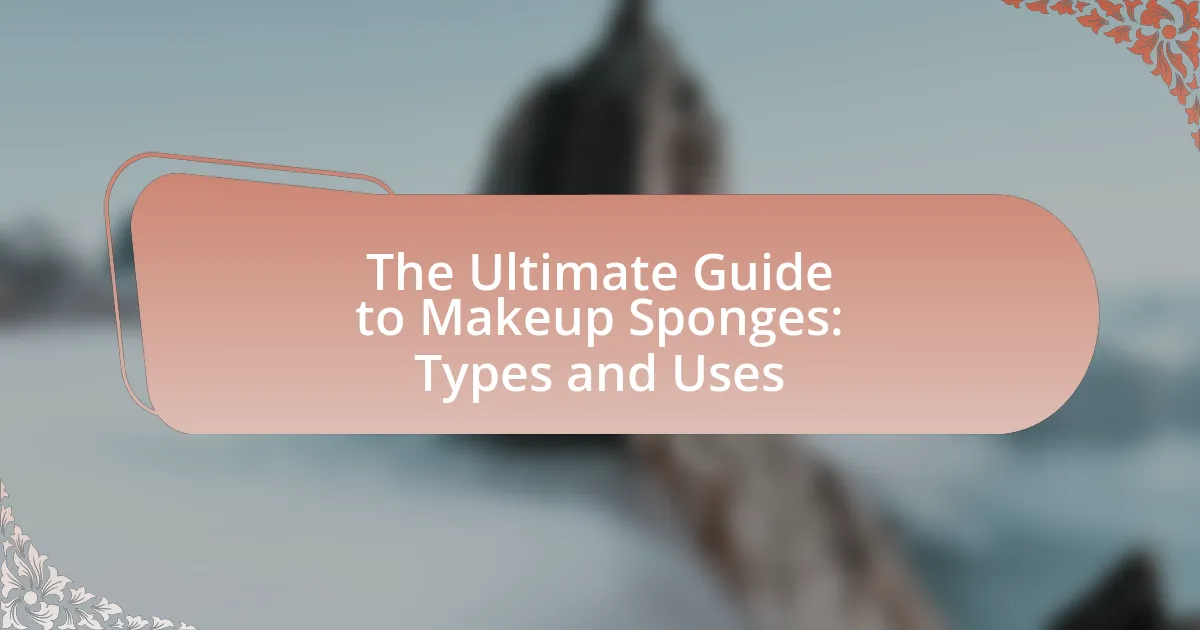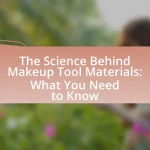Makeup sponges are essential tools for applying and blending makeup products, particularly foundation and concealer, to achieve a smooth and even finish. This guide covers the various types of makeup sponges, including classic wedge sponges, beauty blenders, silicone sponges, and microfiber sponges, highlighting their unique features, materials, and shapes. It also discusses the advantages of using makeup sponges over other application tools, techniques for effective use, and best practices for cleaning and maintenance. Additionally, the article provides insights on selecting the right sponge based on skin type and makeup preferences, ensuring optimal application results.
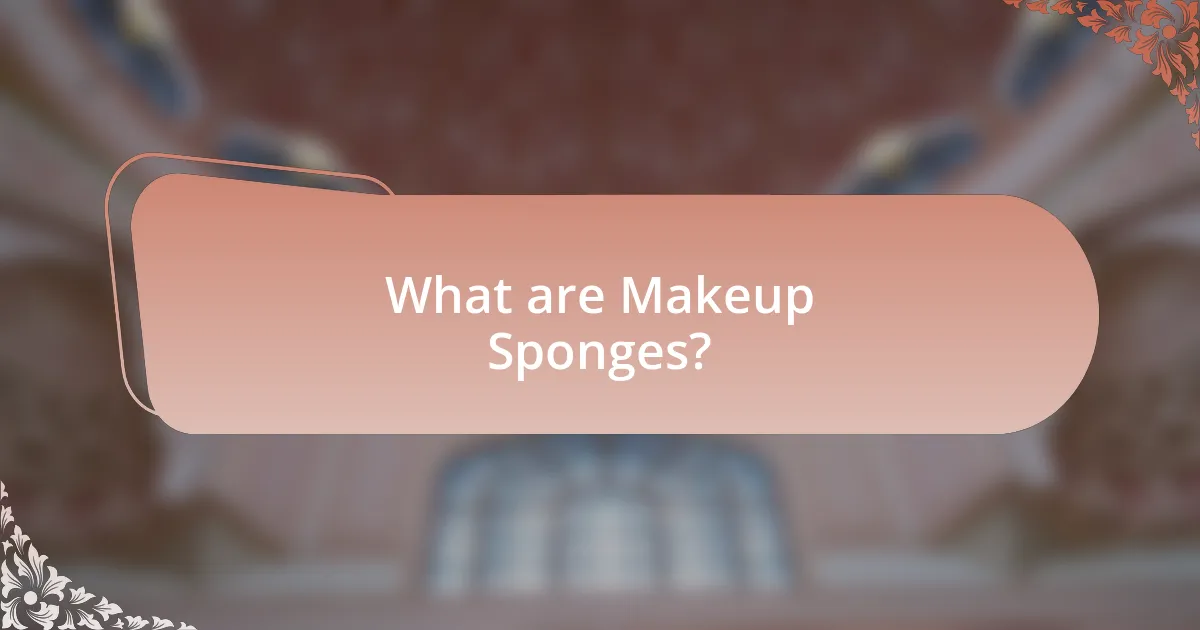
What are Makeup Sponges?
Makeup sponges are tools used for applying and blending makeup products, primarily foundation, concealer, and other liquid or cream formulations. These sponges are designed to create a smooth, even finish on the skin by allowing for seamless blending and buildable coverage. The most common types of makeup sponges include the classic wedge sponge, the beauty blender, and various shapes that cater to different application techniques. Their porous texture helps to absorb excess product while distributing makeup evenly, enhancing the overall appearance of the skin.
How do Makeup Sponges differ from other application tools?
Makeup sponges differ from other application tools primarily in their texture and blending capabilities. Unlike brushes or fingers, makeup sponges are designed to create a seamless finish by absorbing excess product and distributing foundation or concealer evenly across the skin. This unique porous structure allows for a more natural look, as the sponge can be dampened to further enhance blending and hydration, which is not achievable with most brushes. Studies have shown that sponges can reduce makeup application time while providing a more airbrushed effect, making them a preferred choice for many makeup artists and enthusiasts.
What materials are commonly used in Makeup Sponges?
Makeup sponges are commonly made from materials such as polyurethane, latex, and hydrophilic foam. Polyurethane is widely used due to its soft texture and ability to absorb liquids, making it ideal for blending makeup seamlessly. Latex sponges, while less popular due to potential allergies, offer durability and a firm texture for precise application. Hydrophilic foam is known for its ability to expand when wet, allowing for a smoother application of products. These materials are chosen for their specific properties that enhance the effectiveness of makeup application.
What shapes and sizes do Makeup Sponges come in?
Makeup sponges come in various shapes and sizes, including teardrop, flat, and wedge shapes, as well as mini and full-size options. The teardrop shape is designed for blending foundation and concealer, while flat sponges are ideal for applying powder products. Wedge sponges are often used for precise application in hard-to-reach areas. Sizes range from small, which are suitable for targeted application, to larger sponges that cover more surface area for quicker makeup application. This variety allows users to choose sponges that best fit their makeup application needs and preferences.
Why are Makeup Sponges popular in the beauty industry?
Makeup sponges are popular in the beauty industry due to their ability to provide a flawless finish and seamless blending of makeup products. These sponges, often made from soft, porous materials, allow for even application of foundation, concealer, and other products, minimizing streaks and enhancing the overall look. Their versatility is further evidenced by their effectiveness in both liquid and cream formulations, making them a staple in many makeup routines. Additionally, the rise of social media and beauty influencers has contributed to their popularity, as tutorials often showcase the benefits of using sponges for achieving professional-quality results at home.
What advantages do Makeup Sponges offer for makeup application?
Makeup sponges provide several advantages for makeup application, including seamless blending, versatility, and ease of use. Their unique texture allows for a smooth finish, minimizing streaks and enhancing the overall appearance of foundation and other products. Additionally, makeup sponges can be used for various formulations, such as liquids, creams, and powders, making them adaptable for different makeup styles. The ability to dampen the sponge also allows for a more natural, dewy finish, as it helps to hydrate the product and the skin. These benefits are supported by user testimonials and professional makeup artists who frequently recommend sponges for achieving flawless looks.
How do Makeup Sponges enhance the overall makeup look?
Makeup sponges enhance the overall makeup look by providing a seamless application and blending of products. Their unique texture allows for even distribution of foundation, concealer, and other makeup products, resulting in a natural finish. Studies show that using a damp sponge can increase hydration and reduce the appearance of fine lines, as it helps to press the product into the skin rather than sitting on top. This technique not only improves the longevity of the makeup but also creates a more polished and professional appearance.
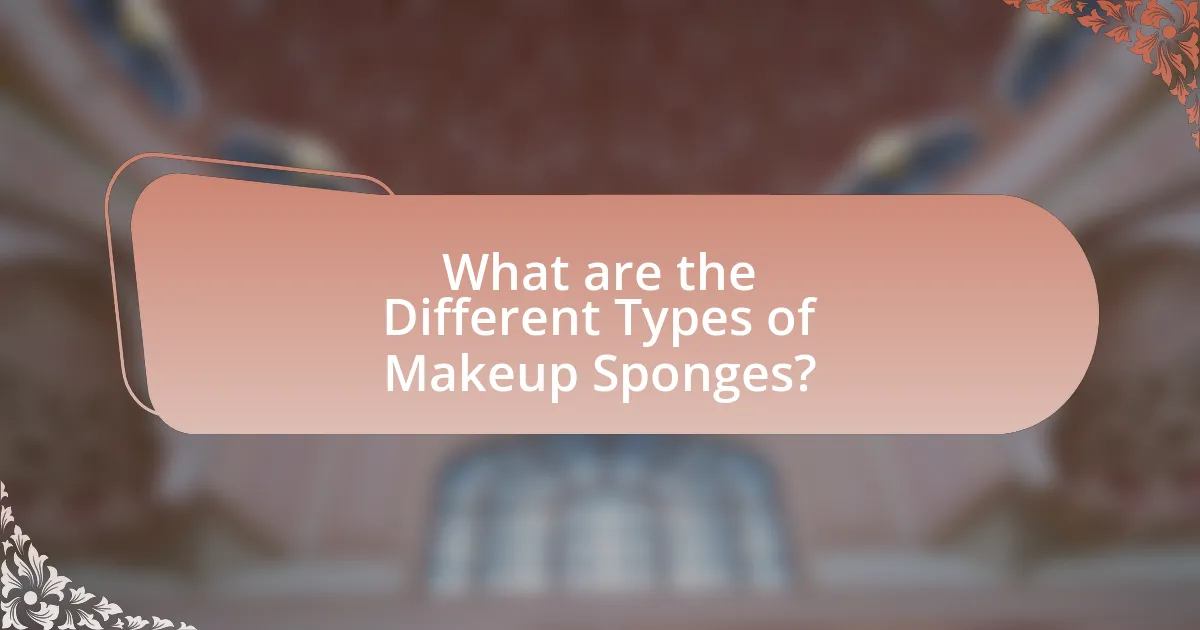
What are the Different Types of Makeup Sponges?
The different types of makeup sponges include the classic wedge sponge, the beauty blender, silicone sponges, and microfiber sponges. The classic wedge sponge is typically made from foam and is used for applying foundation and blending makeup. The beauty blender, a teardrop-shaped sponge, is designed for seamless blending and can be used damp for a more natural finish. Silicone sponges are non-porous and provide a smooth application, minimizing product absorption. Microfiber sponges feature a unique texture that allows for a flawless finish and are often used for applying liquid products. Each type serves specific purposes in makeup application, catering to various preferences and techniques.
What are the characteristics of traditional latex sponges?
Traditional latex sponges are characterized by their porous structure, flexibility, and absorbency. These sponges are made from natural latex rubber, which allows them to easily soak up liquids and provide a smooth application for makeup products. Their soft texture enables them to blend makeup seamlessly into the skin, making them a popular choice for foundation and concealer application. Additionally, traditional latex sponges can be easily cleaned and reused, although they may degrade over time due to exposure to moisture and makeup products.
How do latex sponges compare to non-latex options?
Latex sponges are generally more elastic and provide a firmer texture compared to non-latex options, which are often softer and more absorbent. The elasticity of latex sponges allows for better control during application, making them suitable for precise makeup techniques. In contrast, non-latex sponges, such as those made from polyurethane or silicone, tend to absorb more product, which can lead to a more natural finish but may require more frequent replacement due to wear and tear. Additionally, latex sponges can cause allergic reactions in some individuals, while non-latex options are hypoallergenic, making them a safer choice for sensitive skin.
What are the best uses for traditional latex sponges?
Traditional latex sponges are best used for applying and blending makeup products, particularly foundation and concealer. Their porous texture allows for even distribution of liquid and cream products, resulting in a smooth finish. Additionally, traditional latex sponges can be utilized for touch-ups and correcting makeup mistakes due to their absorbent nature, which helps to lift excess product without disturbing the underlying layers.
What are the benefits of using beauty blenders?
Beauty blenders provide several benefits, including seamless application of makeup, versatility in use, and ease of cleaning. The unique sponge texture allows for a smooth, airbrushed finish, which enhances the overall appearance of foundation and concealer. Additionally, beauty blenders can be used for various products, such as creams, liquids, and powders, making them a multifunctional tool in makeup routines. Their design also facilitates easy cleaning, as they can be washed with soap and water or specialized cleansers, ensuring hygiene and longevity.
How do beauty blenders improve foundation application?
Beauty blenders improve foundation application by providing a seamless, airbrushed finish that enhances the overall look of makeup. The unique sponge material allows for even distribution of foundation, minimizing streaks and patches. Additionally, when dampened, beauty blenders expand, allowing for better absorption of product and reducing waste, which leads to a more natural appearance on the skin. Studies have shown that using a damp sponge can increase the hydration of the foundation, resulting in a more dewy finish.
What techniques can be used with beauty blenders for optimal results?
To achieve optimal results with beauty blenders, techniques such as dampening the sponge, using a stippling motion, and blending in sections are essential. Dampening the beauty blender before use allows for a smoother application and prevents the sponge from absorbing too much product, ensuring even coverage. Employing a stippling motion, where the sponge is gently patted onto the skin, helps to build coverage without disturbing the underlying layers of makeup. Additionally, blending in sections allows for better control and precision, ensuring that each area of the face is evenly blended for a flawless finish. These techniques are widely recommended by makeup artists and beauty experts for their effectiveness in enhancing makeup application.
What are the unique features of silicone sponges?
Silicone sponges are unique due to their non-porous surface, which prevents product absorption and allows for easy cleaning. This feature enables users to apply makeup smoothly and evenly while minimizing waste, as the sponge does not soak up liquid products like foundation or concealer. Additionally, silicone sponges are hypoallergenic and resistant to bacteria, making them suitable for sensitive skin. Their durability also contributes to their appeal, as they can last longer than traditional sponges without degrading.
How do silicone sponges affect product usage and waste?
Silicone sponges reduce product usage and waste by providing a non-absorbent surface that minimizes the amount of makeup absorbed compared to traditional sponges. This characteristic allows users to apply makeup more efficiently, as less product is wasted during application. Studies indicate that silicone sponges can use up to 50% less product than conventional sponges, leading to less frequent repurchase of makeup products and a decrease in overall waste generated from discarded packaging.
What are the best practices for cleaning silicone sponges?
The best practices for cleaning silicone sponges include rinsing them under warm water immediately after use, applying a gentle soap or cleanser, and using your fingers to work the soap into the sponge to remove makeup residue. Afterward, thoroughly rinse the sponge until the water runs clear to ensure all soap is removed. It is also advisable to sanitize the sponge regularly by soaking it in a mixture of water and vinegar or rubbing alcohol for a few minutes, followed by rinsing. These methods effectively eliminate bacteria and prolong the lifespan of the silicone sponge.
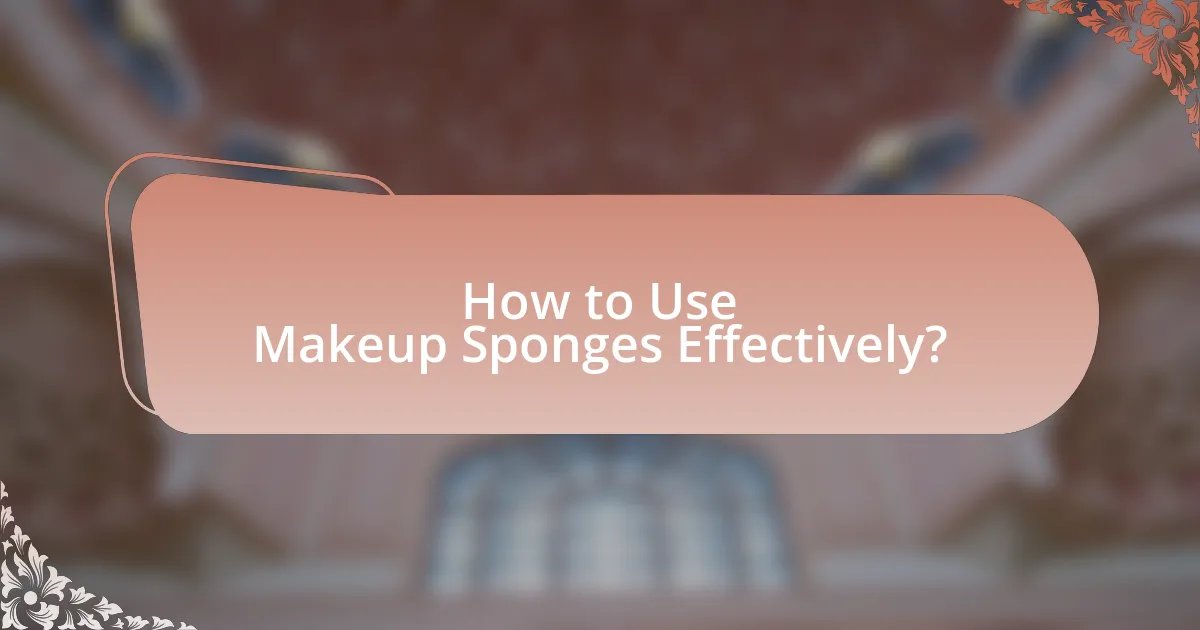
How to Use Makeup Sponges Effectively?
To use makeup sponges effectively, dampen the sponge before application to achieve a smoother finish and prevent product absorption. This technique allows the sponge to blend foundation, concealer, or other products seamlessly into the skin, resulting in a more natural look. Studies show that damp sponges can reduce the amount of product needed by up to 50%, enhancing coverage while minimizing waste. Additionally, using a stippling motion rather than dragging the sponge helps to build coverage gradually and evenly.
What techniques should be used for applying foundation with a sponge?
To apply foundation with a sponge effectively, use a dabbing technique. This involves picking up foundation with the sponge and gently pressing it onto the skin, which helps to achieve an even and natural finish. The sponge should be dampened before use, as this allows for better blending and prevents the sponge from absorbing too much product. Additionally, start from the center of the face and work outward, which helps to distribute the foundation evenly while avoiding heavy coverage in any one area. This method is supported by makeup artists who emphasize that a damp sponge enhances the foundation’s application by creating a seamless look.
How can you achieve a flawless finish with a makeup sponge?
To achieve a flawless finish with a makeup sponge, dampen the sponge before use to enhance blending and prevent product absorption. A damp sponge allows for smoother application and a more natural finish, as it helps to evenly distribute foundation or concealer without leaving streaks. Additionally, using a stippling motion rather than dragging the sponge across the skin ensures that the product is seamlessly blended into the complexion. This technique minimizes the appearance of pores and imperfections, resulting in a polished look.
What common mistakes should be avoided when using makeup sponges?
Common mistakes to avoid when using makeup sponges include not wetting the sponge before use, applying too much product, and failing to clean the sponge regularly. Wetting the sponge helps to achieve a more natural finish and prevents excessive product absorption, which can lead to a cakey appearance. Applying too much product can result in uneven application and wastage, while neglecting to clean the sponge can harbor bacteria, leading to skin issues. Regular cleaning is essential for maintaining hygiene and ensuring optimal performance of the sponge.
How can you maintain and clean your makeup sponges?
To maintain and clean your makeup sponges, regularly wash them with a gentle soap or a specialized sponge cleanser. This process involves wetting the sponge, applying the cleanser, and gently massaging it to remove makeup and bacteria. Rinse thoroughly under running water until the water runs clear, ensuring no soap residue remains. It is recommended to clean sponges after every use to prevent the buildup of bacteria, which can lead to skin irritation or breakouts. Studies indicate that unclean sponges can harbor harmful bacteria, emphasizing the importance of regular cleaning for skin health.
What are the best cleaning products for makeup sponges?
The best cleaning products for makeup sponges include gentle liquid soap, dish soap, and specialized sponge cleansers. Gentle liquid soap effectively breaks down makeup residue without damaging the sponge material. Dish soap is also effective due to its grease-cutting properties, making it suitable for removing oil-based products. Specialized sponge cleansers, such as those from brands like Beautyblender and Real Techniques, are formulated specifically for this purpose and often contain ingredients that help maintain the sponge’s integrity while ensuring thorough cleaning.
How often should you replace your makeup sponges?
You should replace your makeup sponges every three to six months. Regular replacement is essential because sponges can harbor bacteria, which may lead to skin irritation or breakouts. According to dermatologists, using old sponges increases the risk of transferring bacteria to the skin, making timely replacement crucial for maintaining skin health.
What are some tips for choosing the right makeup sponge for your needs?
To choose the right makeup sponge for your needs, consider the sponge’s material, shape, and size. Different materials, such as latex, polyurethane, or silicone, affect the application and finish of makeup; for instance, polyurethane sponges are popular for their softness and ability to blend products seamlessly. The shape of the sponge can influence precision; a pointed tip is ideal for hard-to-reach areas, while a rounded base is better for larger surfaces. Additionally, the size of the sponge should match the area of application; smaller sponges work well for detailed work, while larger ones are suitable for full-face coverage. These factors ensure that the sponge meets your specific makeup application requirements effectively.
How do skin type and makeup preferences influence sponge selection?
Skin type and makeup preferences significantly influence sponge selection by determining the texture and density of the sponge needed for optimal application. For instance, individuals with dry skin may prefer softer, more absorbent sponges that provide hydration and a dewy finish, while those with oily skin might opt for firmer sponges that help control excess oil and achieve a matte look. Additionally, makeup preferences, such as the choice between liquid or powder products, dictate the sponge type; a dense sponge is ideal for liquid foundations, while a lighter, more porous sponge works better for powders. This alignment between skin characteristics and makeup application techniques ensures a seamless finish and enhances the overall makeup experience.
What factors should you consider when purchasing a makeup sponge?
When purchasing a makeup sponge, consider the material, shape, size, and density. The material affects the sponge’s ability to absorb product; for instance, latex sponges are firm and durable, while foam sponges provide a softer application. The shape influences application techniques; a pointed tip is ideal for precision, while a rounded base covers larger areas. Size matters for the area of application; smaller sponges are suitable for detailed work, while larger ones are better for foundation. Density impacts how much product the sponge holds; denser sponges may provide fuller coverage, while lighter ones offer a more sheer finish.
